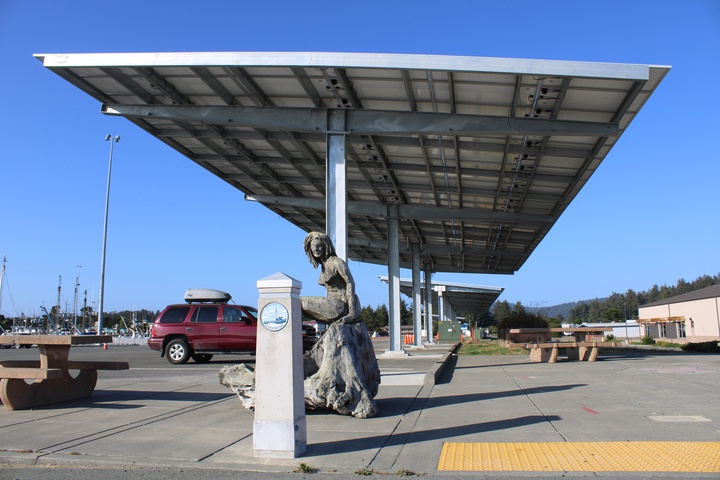Jessica Cejnar / Tuesday, May 18, 2021 @ 5:37 p.m. / Local Government
Crescent City Harbor's Solar Panels Beginning to Pay Off, Commissioner, Consultant Says

Nearly a year after solar panels were first installed at the Crescent City Harbor, the port is beginning to see energy savings. File photo: Jessica Cejnar
Nearly a year after solar panels were installed on the rooftops and near the inner-boat basin at the Crescent City Harbor, Board President Brian Stone says the port is beginning to see savings on its energy costs.
Flourishing a copy of the Harbor District’s most recent energy bill and comparing it to the previous month’s bill, Stone said Tuesday the port went from owing Pacific Power $7,905.50 to receiving a credit of $1,286.86.
But while the harbor is saving about 1 to 2.5 cents per kilowatt hour on its energy costs as a result of the solar panels, Renewable Energy Capital CEO Alex Lemus told commissioners usage at a meter powering the Ice Plant had dropped, resulting in a reduction in potential savings.
“That is one that’s not saving as much as we had projected and I’m going to propose a move to another meter,” Lemus said.
According to Lemus, that meter was billed at $253, while others powered by the rooftop solar panels and the carport system produced so much electricity, they had negative balances on the harbor’s electricity bill.
“You’re hitting the sweet spot of the year in your part of the country for production, there are a lot of credits and they will be more credits than usage,” he said, adding that REC will work with Pacific Power to make sure the harbor can begin to use those credits when usage increase and production decreases later in the year. “I’m very very happy with the production now. The system is working well and I’m very happy with the impact it’s had on the bottomline, which is your power bills.”
The Crescent City Harbor District, hoping to save about $35,000 annually on its electricity payments, entered into a power purchase agreement with Lemus and Florida-based Renewable Energy Capital in 2017.
In February, 2018, commissioners met with Diversified Energy of Costa Mesa, which would finance, build and maintain the rooftop solar panels and the canopies. But in October 2019 — after the ADE representatives that had worked with port staff were no longer with the company — the harbor district put a lien on roughly $700,000 worth of solar panels, using them as leverage for ADE or REC to complete the project.
Toward the end of 2019, Lemus paid the lien and apologized to the harbor district. Both parties negotiated a new power purchase agreement.
On Tuesday, Lemus said historically, the harbor district had paid between 15.5 cents up to 18 per kilowatt hours on each of its meters. The power purchase agreement both parties agreed to promised to knock those payments down to about 14.5 cents per kilowatt hour, he said. Lemus said the projected savings had dwindled a bit because usage on the meter at the Ice Plant had dropped.
Commissioner Rick Shepherd, who is also president of the Crescent City Commercial Fisherman’s Marketing Association, said the Ice Plant shut off its freezers as a money-saving measure in response to the poor crab season.
“This year was so poor, not many fishermen stayed fishing, so the company shut the freezers off to save money,” Shepherd said. “They won’t be fired up again until next November.”
According to Shepherd, the Ice Plant’s freezers are generally shut down at least five months out of the year.
Lemus noted that Crescent City and Del Norte County is unique in that peak electricity usage occurs in December, January and February, during the winter. He said he couldn’t think of another solar project in the United States where that was the case.
“That’s when we can take advantage of the net metering program where it lets you carry forward credits,” he said, adding that he wanted to press Pacific Power to allow REC to apply its kilowatt hour credits to a different meter at the port.
In response to a question from former Del Norte County supervisor Roger Gitlin about who would maintain the solar panel systems, Lemus said that responsibility falls to REC.
“In addition to that, we’re monitoring the system,” Lemus said. “That’s why we had to wait for modems to be connected to the back of inverters so we can track what the production is every day by the hour and compare that to the baseline reports we have. So if there’s anything wrong, we can get somebody there to address it. What we’re really starting to see, and I’m really happy with this, is now as the days get longer, we’re generating a lot more power.”
CLICK TO MANAGE